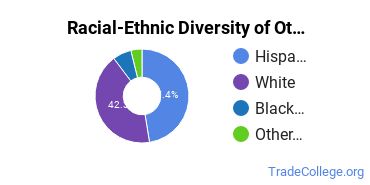Other Culinary Arts
Featured schools near , edit
Types of Degrees Other Culinary Arts Majors Are Getting
The following table lists how many other culinary arts & related services graduations there were in 2021-2022 for each degree level.
| Education Level | Number of Grads |
|---|---|
| Undergraduate Certificate | 224 |
| Associate Degree | 56 |
| Basic Certificate | 21 |
| Bachelor’s Degree | 20 |
Who Is Getting an Associate’s Degree in Other Culinary Arts?
Racial-Ethnic Diversity
At the countrywide level, the racial-ethnic distribution of other culinary arts & related services majors is as follows:

| Race/Ethnicity | Number of Grads |
|---|---|
| Asian | 0 |
| Black or African American | 2 |
| Hispanic or Latino | 31 |
| White | 22 |
| International Students | 0 |
| Other Races/Ethnicities | 1 |
Online Other Culinary Arts Programs
The following table lists the number of programs by degree level, along with how many schools offered online courses in the field.
| Degree Level | Colleges Offering Programs | Colleges Offering Online Classes |
|---|---|---|
| Certificate (Less Than 1 Year) | 0 | 0 |
| Certificate (1-2 years) | 9 | 0 |
| Certificate (2-4 Years) | 2 | 0 |
| Associate’s Degree | 13 | 4 |
| Bachelor’s Degree | 0 | 0 |
| Post-Baccalaureate | 0 | 0 |
| Master’s Degree | 1 | 0 |
| Post-Master’s | 0 | 0 |
| Doctor’s Degree (Research) | 1 | 0 |
| Doctor’s Degree (Professional Practice) | 0 | 0 |
| Doctor’s Degree (Other) | 0 | 0 |
Explore Major by State
Alabama
California
District of Columbia
Idaho
Kansas
Maryland
Mississippi
Nevada
New York
Oklahoma
South Carolina
Utah
West Virginia
Alaska
Colorado
Florida
Illinois
Kentucky
Massachusetts
Missouri
New Hampshire
North Carolina
Oregon
South Dakota
Vermont
Wisconsin
Trades Related to Other Culinary Arts
You may also be interested in one of the following majors related to other culinary arts & related services.
References
*The racial-ethnic minorities count is calculated by taking the total number of students and subtracting white students, international students, and students whose race/ethnicity was unknown. This number is then divided by the total number of students at the school to obtain the racial-ethnic minorities percentage.
- College Factual
- College Scorecard
- National Center for Education Statistics
- O*NET Online
- U.S. Bureau of Labor Statistics
- Usual Weekly Earnings of Wage and Salary Workers First Quarter 2020
- Image Credit: By U.S. Army Europe Images under License
More about our data sources and methodologies.
Featured Schools
 Request Info
Request Info
|
Southern New Hampshire University You have goals. Southern New Hampshire University can help you get there. Whether you need a bachelor's degree to get into a career or want a master's degree to move up in your current career, SNHU has an online program for you. Find your degree from over 200 online programs. Learn More > |
